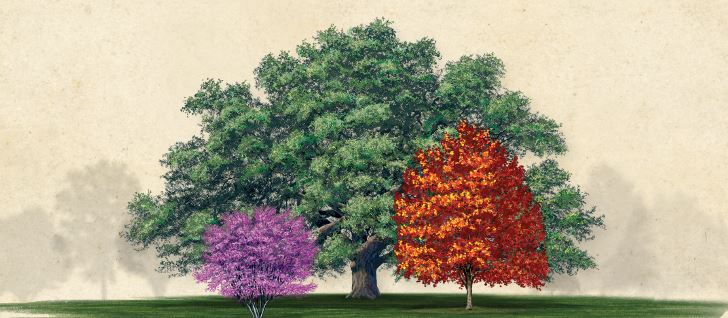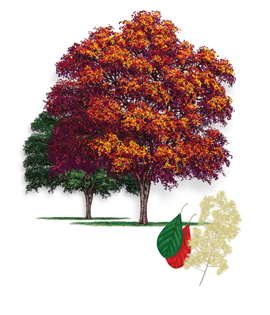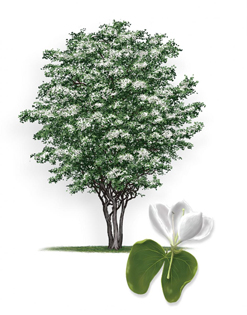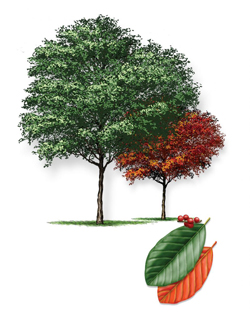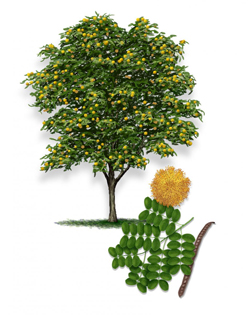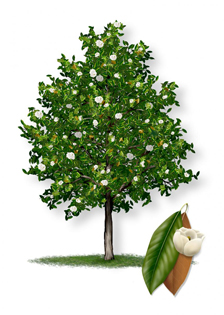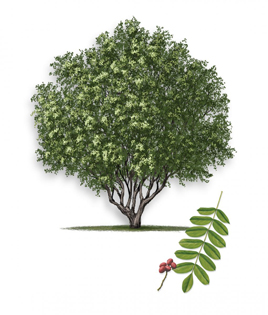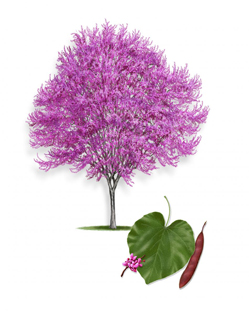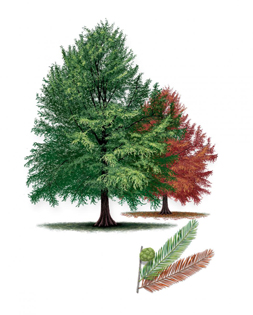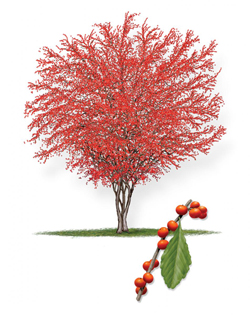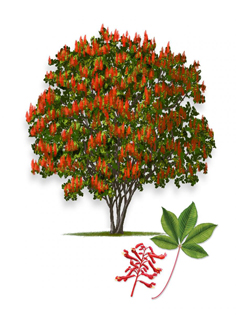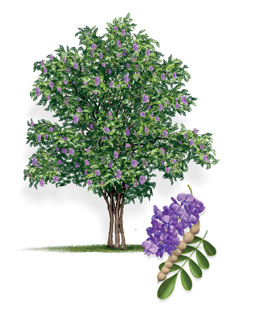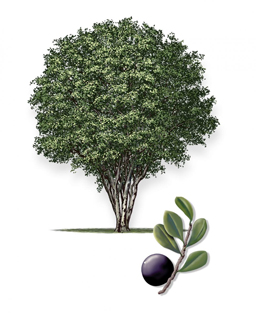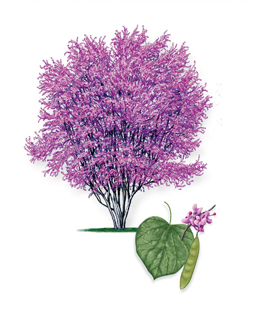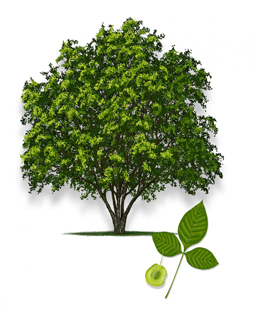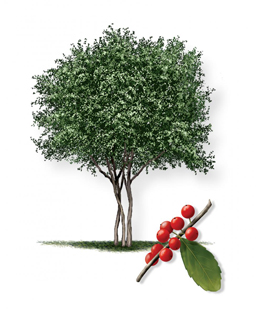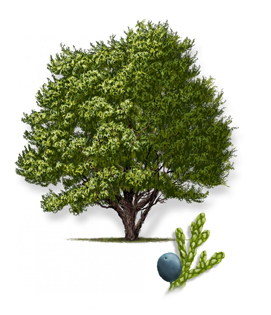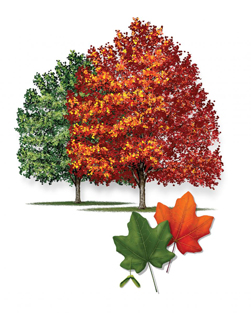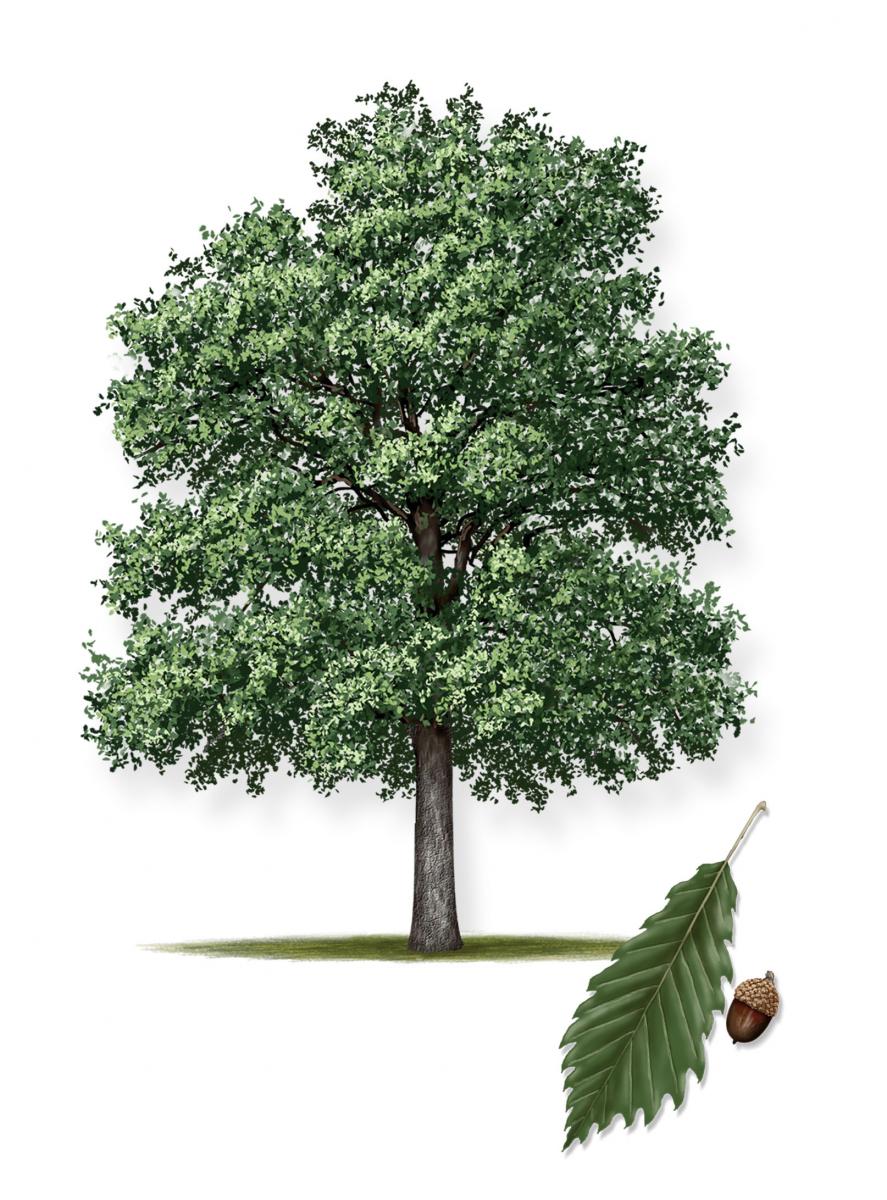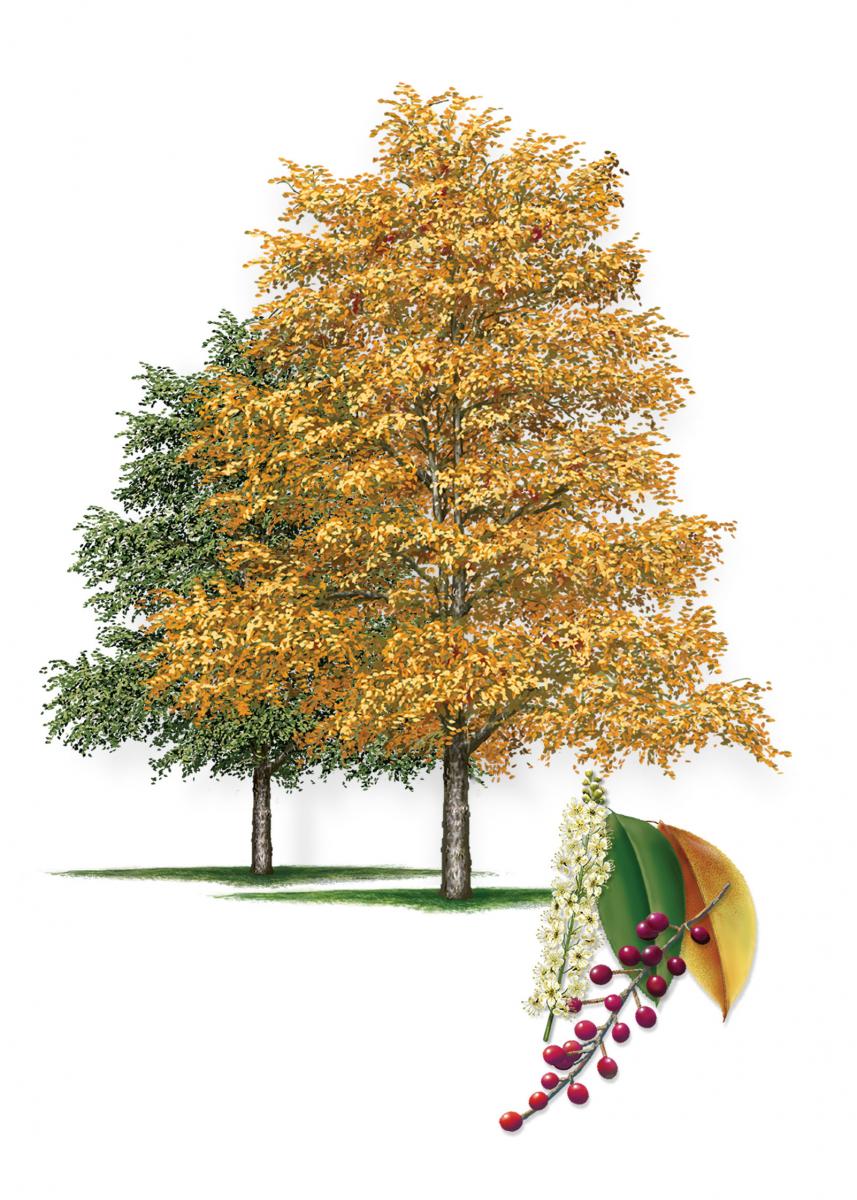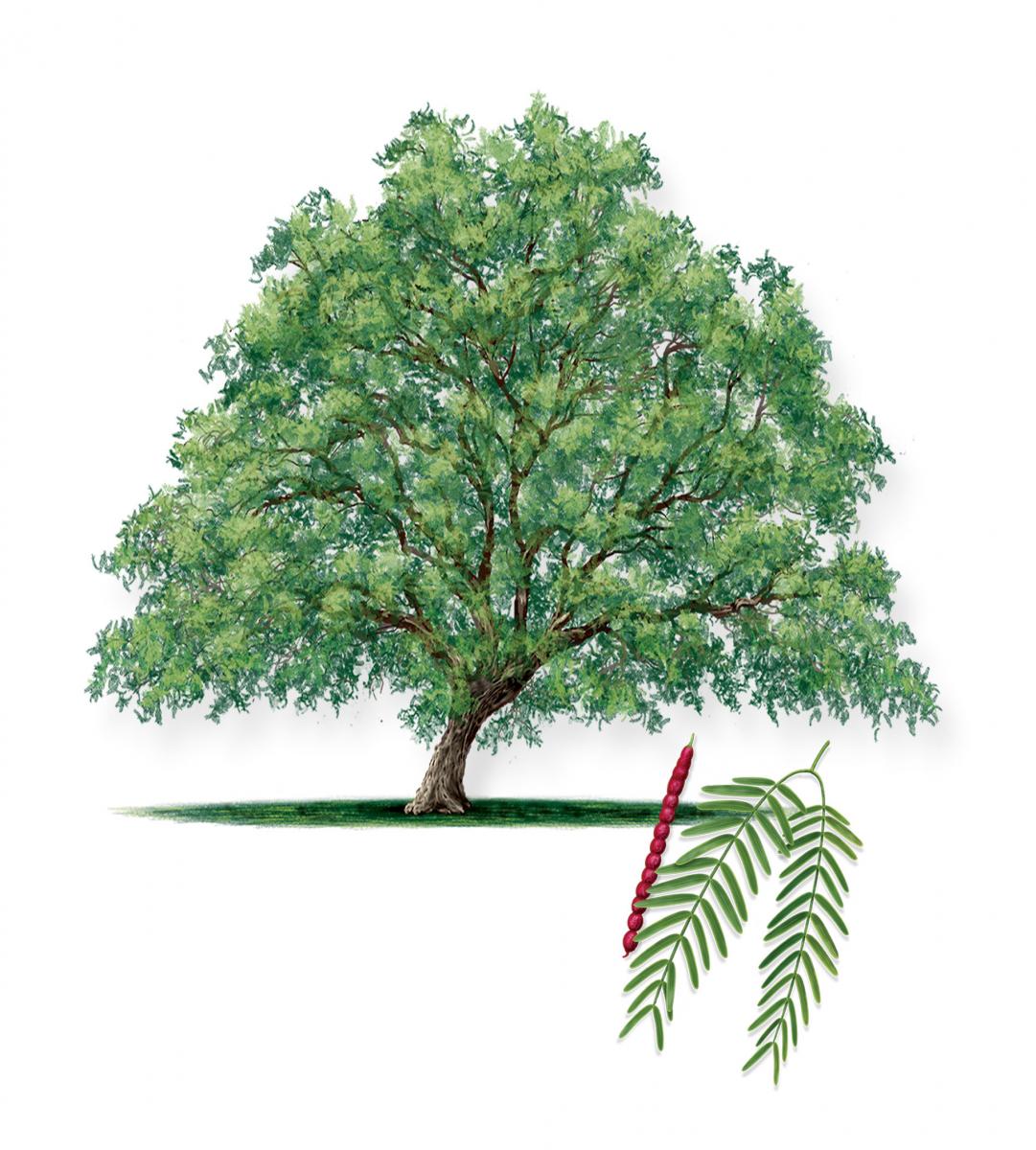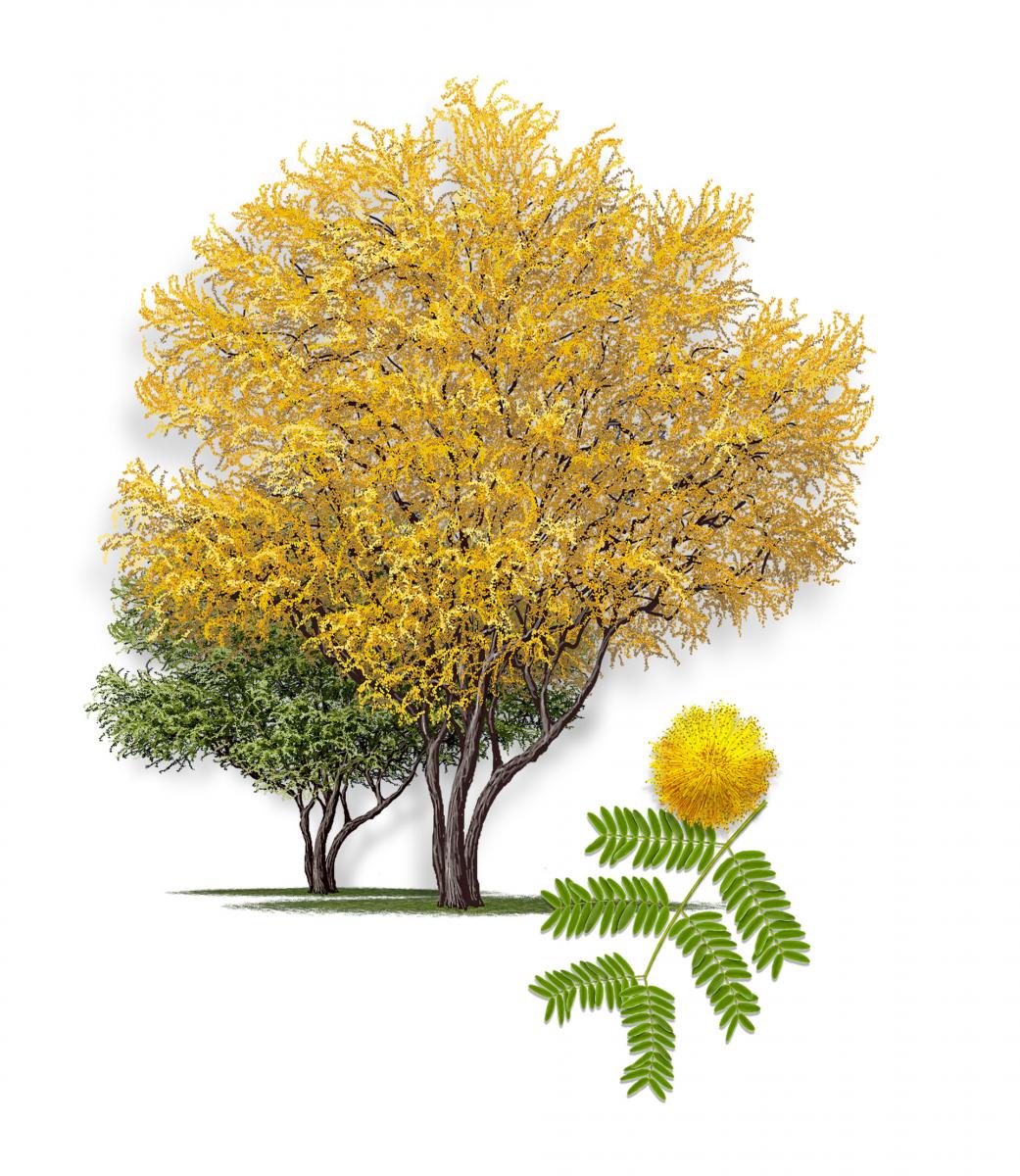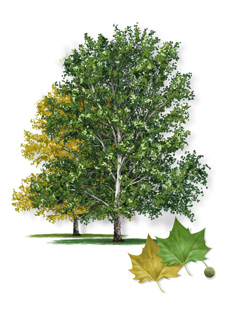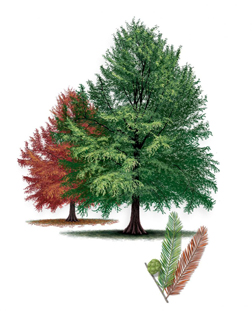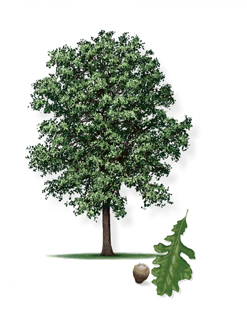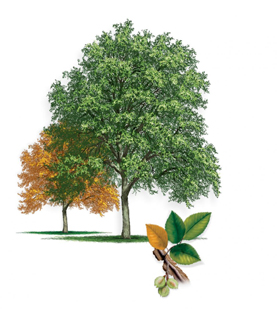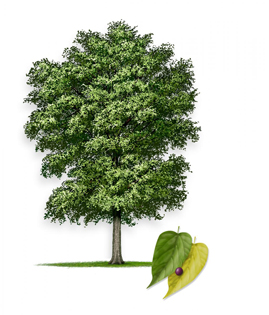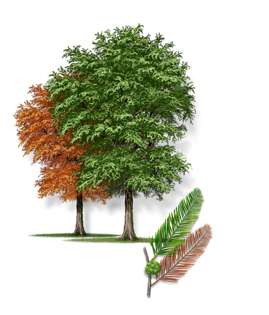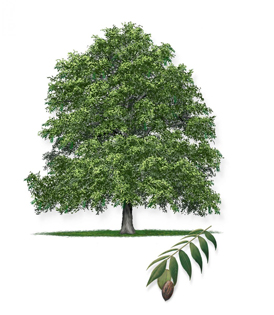Forest Trail at Austin Nature & Science Center
The Austin Nature & Science Center’s Forest Trail is a permanent self-guided exhibit that includes forty-five trees planted and maintained site-wide to encourage the selection of native trees appropriate for commercial and residential landscapes in Austin and Central Texas. The exhibit’s artistic signage, in English and Spanish, identifies each tree with a common name and scientific name, mature height, tree facts, and whether it is deciduous or evergreen.
Contact Information
Austin Nature & Science Center |
Overview
Overview 1 of 1
Right Tree, Right Place, Right Reason
The Austin Nature & Science Center’s Forest Trail's catch phrase, Right Tree • Right Place • Right Reason, serves as an easy reminder to do some research and ask some questions before selecting and investing in a tree. This will help to ensure a successful long-term outcome that costs less to maintain, gives confidence that the chosen tree will fulfill its intended purpose, and avoids unintended problems as it grows.
Choosing the Right Tree
Learning a few key facts about a tree can help you choose the right tree for your project, location and budget. Consider why you are planting a tree, the tree’s role in the landscape, and what it will need to grow and thrive. Soil types, depth, and moisture content vary widely in this region and are a key factor in tree selection.
Allow adequate room for the tree to grow to its natural height and width that considers proper spacing between trees and permanent elements like sidewalks, buildings, utilities in the ground and above, and aesthetics.
A tree can live between fifteen and hundreds of years, depending on genus and species, so time spent considering these factors is well spent.
The Forest Trail exhibit’s theme and focus is encouraging people to choose and plant trees regionally native to Central Texas because these trees are well adapted to Austin’s local conditions, sustain local wildlife, and are in keeping with its local identity. Wherever you live, please consider planting trees native to your location.
Why an Urban Forest is Vital
Austin’s urban forest—its tree canopy—is vital to water and air quality and helps mitigate the urban heat island effect. It’s a healthy and sustainable mix of trees, vegetation, and other components that comprise a contiguous and thriving ecosystem valued, protected, and cared for by the City and all of its citizens as an essential environmental, economic, and community asset.
Funding for the trail generously provided by a City of Austin - Urban Forest Grant. The Urban Forest Grant (UFG) has been established to promote conservation and improvement projects that benefit Austin’s urban forest.
Trees
Trees 1 of 3
Small Trees
Small trees at the Austin Nature & Science Center’s Forest Trail.
 American Smoke Tree
American Smoke TreeAmerican Smoke Tree (Cotinus obovatus)
- 6' - 12' (1.8m -- 3.7m)
- Large flower clusters resemble "smoke"
- Deciduous Caducifolio
Racimos de flares grandes que semejan ''humo''
Artwork © Robert O’Brien.
 Anacacho Orchid Tree
Anacacho Orchid TreeAnacacho Orchid Tree (Bauhinia lunarioides)
- 10' - 15' (3m - 4.6m)
- Unique foliage and showy white, sometimes pink, flowers
- Deciduous Caducifolio
Follaje único con flores blancas vistosas, algunas veces rosas
Artwork © Robert O’Brien
 Bubba Desert Willow
Bubba Desert WillowBubba Desert Willow (Chilopsis linearis 'Bubba')
- 15' - 25' (4.6m - 7.6m)
- This cultivar's large purple flowers attract pollinators; not a true willow.
- Deciduous Caducifolio
Las flores grandes moradas de esta variedad cultivada atraen polinizadores; no es un árbol de sauce en sí
Artwork © Robert O’Brien
 Caroline Buckthorn
Caroline BuckthornCarolina Buckthorn (Frangula caroliniana)
- 6' - 12' (1.8m - 3.7m)
- Showy small tree with glossy foliage; berries for wildlife
- Deciduous Caducifolio
Pequeño árbol vistoso con follaje brillante; frutas del bosque para la vida salvaje
Artwork © Robert O’Brien
 Eve’s Necklace
Eve’s NecklaceEve's Necklace (Stryphnolobium affine)
- 15' - 25' (4.6m - 7.6m).
- Lovely pink spring blooms followed by interesting seed pods
- Deciduous Caducifolio
Bonitas flores rosas durante la p·rimavera, seguidas por vainas de semillas interesantes
Artwork © Robert O’Brien
 Goldenball Leadtree
Goldenball LeadtreeGoldenball Leadtree (Leucaena retusa)
- 15' - 20' (4.6m - 6.1m)
- Fragrant yellow puffball flowers throughout the growing season
- Deciduous Caducifolio
Flores en forma de bolas de algodón fragantes de color amarillo durante la temporada de crecimiento
Artwork © Robert O’Brien
 Little Gem Southern Magnolia
Little Gem Southern MagnoliaLittle Gem Southern Magnolia (Magnolia grandiflora 'Little Gem')
- 15' - 25' (4.6m - 7.6m)
- Dwarf cultivar with a dense pyramid shape; fragrant large white flowers
- Evergreen Perennifolios
Variedad enana cultivada con una forma de pirámide densa; flores blancas grandes y fragantes
Artwork © Robert O’Brien
 Mexican Buckeye
Mexican BuckeyeMexican Buckeye (Ungnadia speciosa)
- 12' - 20' (3.7m - 6.1m)
- Not a true buckeye, but has similar large seeds; showy pink spring blooms
- Deciduous Caducifolio
No un castaño de indias en sí, pero tiene semillas grandes similares; flores rosas vistosas durante la primavera
Artwork © Robert O’Brien
 Mexican Pistachio
Mexican PistachioMexican Pistachio (Pistacia mexicana)
- 12' - 20' (3.7m - 6.1m)
- Ornamental tree with white spring blooms and showy red growth
- Evergreen Perennifolios
Árbol ornamental con flores blancas en la primavera y que crecen hasta mostrar un color rojizo vistaoso
Artwork © Robert O’Brien
 Mexican Plum
Mexican PlumMEXICAN PLUM Mexican Plum (Prunus mexicana)
- 15' - 25' (4.6m - 7.6m)
- Fragrant white flowers in early spring; provides tasty fruit
- Deciduous Caducifolio
Flores blancas fragantes al inicio de la primavera; da una fruta de sabot agradable
Artwork © Robert O’Brien
 Mexican Redbud
Mexican RedbudMexican Redbud (Cercis canadensis var. mexicana)
- 15' - 20' (4.6m - 6.1m)
- More drought tolerant than other reginal redbuds with smaller, glossy, wavy-edged leaves
- Deciduous Caducifolio
Tolera la sequía más que otros árboles de ciclamor con hojas más pequeñas, brillantes y con orillas onduladas
Artwork © Robert O’Brien
 Oklahoma Redbud
Oklahoma RedbudOklahoma Redbud (Cercis canadensis var. texensis 'Oklahoma')
- 15' - 25' (6.1m - 4.6m)
- This cultivar sports darker pink flowers; vigorous, healthy growth habit
- Deciduous Caducifolio
Esta variedad de cultivo muestra flores rosas de color obscuro; con un hábito de crecimiento sano y vigoroso
Artwork © Robert O’Brien
 Peve Minaret Bald Cypress
Peve Minaret Bald CypressPeve Minaret Bald Cypress (Taxodium distichum 'Peve Minaret')
- 8' - 12' (2.4m - 3.7m)
- This conifer's dwarf cultivar is better suited to a home landscape
- Deciduous Caducifolio
Este conífero enano de variedad cultivada luce mejor en un proyecto de paisajismo de casa
Artwork © Robert O’Brien
 Possumhaw
PossumhawPossumhaw (Ilex decidua)
- 12' - 20' (3. 7m - 6.1m)
- Orange-red berries throughout winter; high wildlife value
- Deciduous Caducifolio
Frutos del bosque durante todo el invierno; de gran valor para la fauna silvestre
Artwork © Robert O’Brien
 Scarlet Buckeye
Scarlet BuckeyeScarlet Buckeye (Aesculus pavia)
- 5' - 15' (1.Sm - 4.6m)
- Gorgeous large red bloom clusters in mid-spring; summer leaf drop occurs in dry cqnditions
- Deciduous Caducifolio
Grupos de flores grandes de color rojo con una aparienca atractiva a mediados de la primavera; la caída de hojas ocurre durante el verano en condiciones de sequía
Artwork © Robert O’Brien
 Texas Mountain Laurel
Texas Mountain LaurelTexas Mountain Laurel (Sophora secundiflora)
- 12' - 20' (3.7m - 6.1m)
- Fragrant purple grape candy scented blooms in the spring
- Evergreen Perennifolios
Flores fragantes con olor a dulce de uva morada; crece en la primavera
 Texas Persimmon
Texas PersimmonTexas Persimmon (Diospyros texana)
- 10' - 20' (3m - 6.1m)
- Bears fruit attractive to wildlife; peeling bark reveals smooth, colorful trunks·
- Deciduous Caducifolio
Da una fruta que es atractiva para la vida salvaje; al pelar la corteza revela troncos suaves y coloridos
Artwork © Robert O’Brien
 Texas Redbud
Texas RedbudTexas Redbud (Cercis canadensis var. texensis)
- 15' - 20' (4.6m - 6.1m)
- Light pink blooms early spring; more drought tolerant than eastern redbud species
- Deciduous Caducifolio
Flores rosas claro a principios de la primavera; más resistente a la sequía que las especies de árboles de ciclamor de la zona este
Artwork © Robert O’Brien
 Wafer Ash
Wafer AshWafer Ash (Ptelea trifoliata)
- 6' - 15' (1.8m - 4.6m)
- Sweet nectar attracts many pollinators; the seed "hops" were once used for brewing beer
- Deciduous Caducifolio
Un néctar dulce atrae muchos polinizadores; los "lúpulos" de la semilla se usaron en algún momenta para la preparación de cerveza
Artwork © Robert O’Brien
 Yaupon
YauponYaupon (Ilex vomitoria)
- 10'-20' (3m-6.1m)
- Popular small tree with red berries; has weeping, columnar, and dwarf forms
- Evergreen Perennifolios
Árbol pequeño popular con frutas del bosque rojas; tiene formas de ramas caídas, en columna y enanas
Artwork © Robert O’Brien
Trees 2 of 3
Medium Trees
Medium trees at the Austin Nature & Science Center’s Forest Trail.
 Anaqua
AnaquaAnaqua (Ehretia anacua)
- 25' - 40' (7.6m - 12.2m)
- Great source of nectar for pollinators and fruit for birds
- Semi-evergreen Semi-perennifolio
Gran fuente de néctar para polinizadores y fruta para los pájaros
Artwork © Robert O’Brien
 Ashe Juniper
Ashe JuniperAshe Juniper (Juniperus ashei)
- 25' - 35' (7.6m - 10.7m)
- High wildlife value; can be used for a windbreak and screening
- Evergreen Perennifolios
Gran valor para la fauna silvestre; puede ser usado como rompe-vientos y protección
Artwork © Robert O’Brien
 Bigtooth Maple
Bigtooth MapleBigtooth Maple (Acer grandidetatum)
- 25' - 45' (7.6m - 13.7m)
- Three to five-lobed leaves turn bright shades of red, gold, or orange in the fall
- Deciduous Caducifolio
Hojas con tres a cinco lóbulos que toman tonalidades brillantes de rojo, dorado o anaranjado en el otoño
Artwork © Robert O’Brien
 Chinkapin Oak
Chinkapin OakChinkapin Oak (Quercus muehlenbergii)
- 40' - 50' (12.2m - 15.2m)
- Excellent shade tree adapted to limestone soils
- Deciduous Caducifolio
Excelente árbol para proporcionar sombra adaptado a los suelos de piedra caliza
Artwork © Robert O’Brien
 Escarpment Black Cherry
Escarpment Black CherryEscarpment Black Cherry (Prunus serotina var. eximia)
- 20' - 35' (6.1m - 10.7m)
- High wildlife value; attracts pollinators
- Deciduous Caducifolio
Gran valor para la fauna silvestre; atrae polinizadores
Artwork © Robert O’Brien
 Honey Mesquite
Honey MesquiteHoney Mesquite (Prosopis glandulosa)
- 25' - 35' (7.6m - 10.7m)
- Heat and drought tolerant; thornless selection available
- Deciduous Caducifolio
Tolera el calor y la sequía; existe una selección sin espinas
Artwork © Robert O’Brien
 Huisache
HuisacheHuisache (Vachellia farnesiana)
- 20' - 35' (6.1m - 10.7m)
- Fragrant yellow spring flower clusters; a source of perfume since the 19th century
- Deciduous Caducifolio
Racimos de flores fragantes de color amarillo durante la primavera; una fuente para fabricar perfume desde el Siglo 19
Artwork © Robert O’Brien
 Lacey Oak
Lacey OakLacey Oak (Quercus laceyi)
- 15' - 25' (4.6m - 7.6m)
- Summer foliage takes on a bluish smokey appearance
- Deciduous Caducifolio

El follaje durante el verano cambia a una apariencia azul grisácea
Artwork © Robert O’Brien
 Mexican White Oak
Mexican White OakMexican White Oak (Quercus polymorpha)
- 30' - 40' (9.1m - 12.2m)
- Adapted to a variety of landscape conditions; resistant to Oak Wilt disease
- Semi-evergreen Semi-perennifolio

Adaptado a una variedad de condiciones de paisajismo; resistente a la enfermedad llamada "Oak Wilt"
Artwork © Robert O’Brien
 Post Oak
Post OakPost Oak (Quercus stellata)
- Root disturbance and overwatering can be detrimental; mature trees are majestic with large, curving branches
- Deciduous Caducifolio
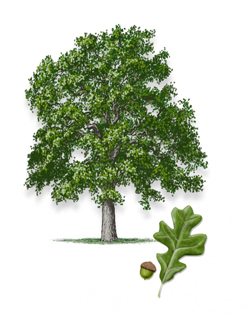
El perturbar la raíz o regar en exceso puede ser perjudicial; los árboles maduros son majestuosos con ramas grandes y curvas
Artwork © Robert O’Brien
 Red Mulberry
Red MulberryRed Mulberry (Morus rubra)
- 25' - 45' (7.6m - 13.7m)
- High wildlife value; tasty fruit
- Deciduous Caducifolio

De gran valor para la fauna silvestre; fruta de sabot agradable
Artwork © Robert O’Brien
 Texas Ash
Texas AshTexas Ash (Fraxinus albicans)
- 30’ - 45’ (9.1m - 13.8m)
- Excellent medium sized tree for a smaller landscape with yellow fall foliage
- Deciduous Caducifolio

Excelente árbol de tamaño mediano para un paisajismo pequeño con follaje amarillo durante el otoño
Artwork © Robert O’Brien
 Texas Red Oak
Texas Red OakTexas Red Oak (Quercus buckleyi)
- 35' - 45' (10.7m - 13.8m)
- Beautiful orange and red fall leaf coloration
- Deciduous Caducifolio

Bella coloración de hojas naranjas y rojas durante el otoño
Artwork © Robert O’Brien
 Western Soapberry
Western SoapberryWestern Soapberry (Sapindus saponaria var. drummondii)
- 30' - 50' (9.1m - 15.2m)
- Fruit used to make soap, adaptable to harsh conditions; has high wildlife value
- Deciduous Caducifolio
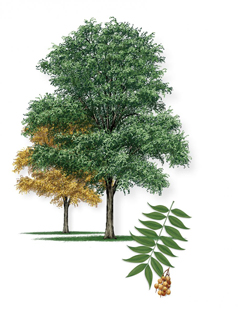
La fruta se usa para hacer jabón, adaptable a condiciones climatológicas agresivas; tiene gran valor para la fauna silvestre
Artwork © Robert O’Brien
 Wright Acacia
Wright AcaciaWright Acacia (Senegalia wrightii)
- 10' - 20' (3m - 6.1m)
- Most cold hardy of the Texas; acacia species; very resistant to pests and diseases
- Deciduous Caducifolio

La más resistente al frio de las especies de acacia en Texas; muy resistente a plagas y enfermedades
Artwork © Robert O’Brien
Trees 3 of 3
Large Trees
Large trees at the Austin Nature & Science Center’s Forest Trail.
 American Sycamore
American SycamoreAmerican Sycamore (Platanus occidentalis)
- 75' - 100' (22.9m - 30.5m)
- Tallest deciduous tree in the United States
- Deciduous Caducifolio
- 2nd generation "Moon Tree" from Apollo 14 Mission
Árbol caducifolio más alto en los Estados Unidos
generación "Arbol de la Luna" de la Misión Apollo 14
Artwork © Robert O’Brien
 Bald Cypress
Bald CypressBald Cypress (Taxodium distichum)
- 75' - 100' (22. 9m - 30.5m)
- Conifer that thrives in moist, deep soils; known for their "knees" that are a special kind of root
- Deciduous Caducifolio
Conífera que crece mucho en suelos húmedos, profundos; conocida por sus "rodillas"que son una raíz especial
Artwork © Robert O’Brien
 Blue Ice Arizona Cypress
Blue Ice Arizona CypressBlue Ice Arizona Cypress (Hesperocyparis arizonica 'Blue Ice')
- 50' - 75' (15.2m - 22.8m)
- This cultivar sports intense, smoky blue foliage; makes a good windbreak or screen
Esta variedad de cultivo muestra un follaje azul, grisáceo; constituye un buen rompe-vientos o protección
Artwork © Robert O’Brien
 Bur Oak
Bur OakBur Oak, (Quercus macrocarpa)
- 50' - 75' (15.2m - 22.9m)
- Largest acorn of all oaks
- Deciduous Caducifolio
La bellota más grande de todos los robles
Artwork © Robert O’Brien
 Cedar Elm
Cedar ElmCedar Elm (UImus crassifolia)
- 50' - 70' (15.2m - 21.3m)
- Adapted to a variety of landscape conditions; yellow fall color
- Deciduous Caducifolio
Adaptado a una variedad de condiciones del bosque; color amarillo en el otoño
Artwork © Robert O’Brien
 Common Hackberry
Common HackberryCommon Hackberry (Celtis occidentalis)
- 25' - 75' (7.6m - 22. 9m)
- Rarely planted but often present; high wildlife value
- Deciduous Caducifolio
Rara vez plantado pero presente muy a menudo; gran valor para la fauna silvestre
Artwork © Robert O’Brien
 Eastern Cottonwood
Eastern CottonwoodEastern Cottonwood (Populus deltoides)
- 65' - 100' (21.3m - 27.4m)
- Fast growing and short lived; best planted in a large rural landscape
- Deciduous Caducifolio
De rápido crecimiento pero de vida corta; es mejor plantado en un área o entorno rural grande
Artwork © Robert O’Brien
 Escarpment Live Oak
Escarpment Live OakEscarpment Live Oak (Quercus fusiformis)
- 35' - 65' (10.7m - 19.8m)
- Popular oak that is smaller than Q. virginiana; better fit for home landscapes
- Evergreen Perennifolios
Roble popular menor al Q. virginiana; más adecuado para jardines caseros
Artwork © Robert O’Brien
 Montezuma Bald Cypress
Montezuma Bald CypressMontezuma Bald Cypress (Taxodium mucronatum)
- Unlike·bald cypress, does not produce root "knees"
- 45' - 70' (13.7m - 21.3m)
- Evergreen Perennifolios
A diferencia del ciprés de los pantanos; no produce raíces en forma de "rodillas"
Artwork © Robert O’Brien
 Pecan
PecanPecan (Carya illinoinensis)
- 50' - 75' (15.2m - 22.9m)
- State Tree of Texas with tasty fruit and high wildlife value
- Deciduous Caducifolio
El árbol del Estado de Texas con fruta de sabot agradable y de gran valor para la fauna silvestre
Artwork © Robert O’Brien
Resources
Resources 1 of 1
Forest Trail Map, Poster & Booklet
Forest Trail Map (jpeg image)
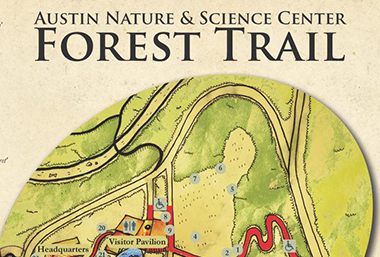
Forest Trail Poster
Download the Forest Trail PDF Booklet and take it with you for some fun, interactive learning activities as you explore the trail.

